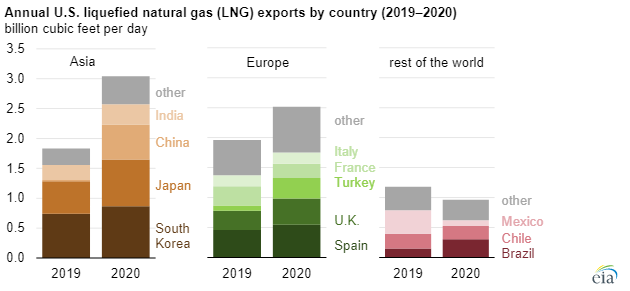New federal data from the Energy Information Administration (EIA) predicts Asian countries will drive the increasing global demand for clean, American natural gas, as more nations seek ways to drive economic growth and meet ambitious climate targets.
A record number of countries (38) imported U.S. natural gas last year, with nearly half of those deliveries reaching countries in Asia, EIA found in its Natural Gas Monthly report. This represents a 67% increase in 2020 compared to 2019 exports.
In 2020, the largest LNG volumes were shipped to China, with Japan and India following. China and India – Asia’s top greenhouse gas emitters – can leverage America’s shale abundance to help reach climate goals targeting emission intensity reductions and plans for net zero emissions in the near future.

America’s energy abundance provides affordable, reliable power at home and is an important foreign policy tool. With access to U.S. natural gas, countries can reduce reliance on Russian-produced energy to meet their needs.
Additionally, U.S. LNG can help reduce energy poverty in third world countries still reliant upon emissions-heavy energy resources like wood chips and animal waste.
“Our allies across the world, especially in developing regions, need affordable and cleaner energy,” MSC’s Callahan recently wrote in the Pittsburgh Post-Gazette. “We have the opportunity to take a leadership role in meeting that demand, rather than ceding ground and political leverage to competing energy-producing nations that don’t produce energy in a way that’s anywhere close to how safely we do it here.”

International demand for U.S. natural gas is set to continue along this upward trend, and America’s top energy leader, newly-confirmed Department of Energy Secretary Jennifer Granholm, has made it clear the federal government recognizes America’s emerging opportunity in this space.
“I believe U.S. LNG exports can have an important role to play in reducing international consumption of fuels that have greater contribution to greenhouse gas emissions,” Granholm told the U.S. Senate Environmental Resources & Energy Committee during her confirmation hearing. “If confirmed as Secretary, I also look forward to working with U.S. industry in ways to reduce emissions associated with this commodity.”
While the majority of the six operating LNG export terminals are located on the Gulf Coast, Maryland’s Cove Point is an important access point for Appalachian producers. But U.S. production and global demand are driving further LNG export expansions, including a proposed loading dock in Gibbstown, New Jersey.




